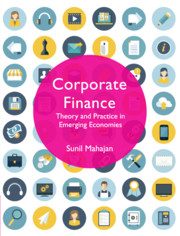Book contents
- Frontmatter
- Contents
- List of Figures
- List of Tables
- List of Corporate Snippets
- List of Abbreviations
- Preface
- Acknowledgements
- 1 Corporate Finance: A Conceptual Introduction
- 2 Financial Markets
- 3 The Time Value of Money
- 4 Capital Budgeting
- 5 Risk and Return
- 6 Valuation
- 7 Capital Structure and Financing
- 8 Dividend Payout: Policy and Practices
- 9 Leverage
- 10 Financial Derivatives
- 11 International Finance
- 12 Working Capital
- 13 Ratio Analysis
- Appendix
- Bibliography
- Index
8 - Dividend Payout: Policy and Practices
Published online by Cambridge University Press: 30 April 2020
- Frontmatter
- Contents
- List of Figures
- List of Tables
- List of Corporate Snippets
- List of Abbreviations
- Preface
- Acknowledgements
- 1 Corporate Finance: A Conceptual Introduction
- 2 Financial Markets
- 3 The Time Value of Money
- 4 Capital Budgeting
- 5 Risk and Return
- 6 Valuation
- 7 Capital Structure and Financing
- 8 Dividend Payout: Policy and Practices
- 9 Leverage
- 10 Financial Derivatives
- 11 International Finance
- 12 Working Capital
- 13 Ratio Analysis
- Appendix
- Bibliography
- Index
Summary
Do you know the only thing that gives me pleasure? It's to see my dividends coming in.
—John D. RockefellerMicrosoft was started, with remarkable success, by Bill Gates and Paul Allen in 1975. Over the next few years, the company established itself as the premier software company in the world. Windows became the standard operating software that everyone installed on their computers. The company earned large profits and accumulated huge cash flows over the years.
However, Microsoft did not pay dividends to its shareholders for the first 28 years of its existence. Then, in 2003, it announced what CFO John Connors (quoted in CBS News, 2003) called ‘a starter dividend’ of US$0.08 per share. A year later, on 20 July 2004, Microsoft stunned the financial markets by announcing plans to pay the single largest cash dividend in the history of the US corporate sector, a one-time dividend of US$3 per share amounting to US$32 billion. In addition, Microsoft announced plans to repurchase up to US$30 billion of its stock over the next four years and pay regular quarterly dividends at an annual rate of US$0.32 per share.
Over the years, Microsoft has been steadily enhancing its dividend payout. The dividend has increased from US$0.32 to US$1.47 per share which amounts to an annual cash outflow of over US$11 billion. Some analysts have started terming Microsoft as a dividend play; they recommend buying Microsoft for its dividend yield and not for potential capital gains. A software company as a dividend play? That too a market leader!
What is the significance of the company's ‘no dividend’ policy prior to 2003 and the high dividends now? Is the dividend policy immaterial, as the Modigliani–Miller Model claims, or does it have a significance beyond just the dividend yield a shareholder obtains?
A company can use its earnings in four ways:
1. Retain and invest in long-term projects
2. Pay off liabilities
3. Pay cash dividends to shareholders
4. Repurchase its own equity (stock buyback)
Cash dividends and the repurchase of equity transfer funds from the company to the shareholders and are the primary means by which shareholders earn from their investments in the company.
- Type
- Chapter
- Information
- Corporate FinanceTheory and Practice in Emerging Economies, pp. 214 - 232Publisher: Cambridge University PressPrint publication year: 2020

